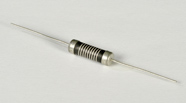In today's business climate, many manufacturers are looking for cost-effective resistors that have high reliability. And with the virtual extinction of the carbon composition resistor, many of these OEMs are turning to carbon film.
Carbon film resistors are designed for high temperature and high voltage applications. They are actually made in a vacuum by breaking down hydrocarbon gases at high temperatures. This in turn forms a carbon deposit on the substrate. The process is accomplished by heating methane or propane gas in a process called high temperature pyrolysis. When the heat is applied, molecular condensation results and hydrogen is released. The end result is carbon. This is a simplified explanation, but the following is the chemical equation for the process.
CH4 yields C + 2H2
The main advantage and reason for using the carbon film resistor is that these components are designed to withstand high voltages as well as high temperatures. The highest voltage the devices can operate up to is 15kV with a nominal temperature of 350°C. They are available with tolerances of 2 percent, 5 percent, 10 percent and 20 percent.
Cutting a helical grove in the carbon film creates the resistive tolerances. The desired resistance value is achieved by regulating the pitch of the helix. The thinner the carbon layer, the finer the pitch and the higher the resistance value. After the helixing or spiraling is completed special alloy contact caps and tinned electrolytic copper connecting wires are pressed onto the ends of the resistor body. The final step involves coating several layers of tan lacquer or using a glass film as a shield. This is done primarily for electrical protection, but also for shielding from the climate.
Carbon film resistors are a good choice because they have a small size for such high ratings and they have a wide resistance range as well. The resistance can be anywhere from 500 Ohms to 100M Ohms. Another plus is that they have no outgassing. This means they will not deposit any vapor into the environment during operation. Outgassing is a condition that causes high material vapor pressure in the device to exert contamination deposits into the air. It corresponds directly to the temperature. These deposits can cause problems with the surrounding equipment.
Some of the other advantages are that they have less stray capacitance and inductance, so they are better at high frequencies. Also, they have a high stability of performance when compared to carbon composition resistors and, of course, they are flame proof.
Dealing with Electrical Noise
Electrical noise is another factor when choosing a resistor. There are two main types of electrical noise, thermal and shot. Thermal noise is the product of the Brownian motion of ionized molecules. This noise cannot be eliminated because it is fundamental to resistance. Carbon film resistors have less of this thermal noise than the carbon composition resistor. The lower values tend to be noise free while increasing with the higher values. Shot noise usually results from the flow of electrons through a highly charged field. It is more prevalent in solid state devices. It is not significant in carbon film resistors and until recently was not even known to exist, with respect to resistors.
There are also some disadvantages when using carbon film resistors. In the first place, they are limited to about 1 percent accuracy. Secondly, they exhibit drift with temperature and vibration. The resistors can have a TCR (temperature coefficient of resistance) range of -250 to -1000 ppm/°C, depending on the resistance value. The advantages, however, seem to outweigh most of the disadvantages, especially in specific applications.
Many Applications
Carbon film resistors are used in many products. Some uses are more optimal than others are, since they withstand higher temperatures and higher voltages. They are ideal for use in mercury vapor lamps, metal halide lamps, high pressure sodium lamps, radar, x-rays, lasers, test equipment, electrical appliances, and high voltage power supplies.
Tepro, a subsidiary of Electro Technik Industries since 1982, was incorporated in 1958 to manufacture wirewound resistors. The company made only wirewound resistors for 35 years; in 1993, Tepro acquired Vamistor Corp. and with it the Tenn-R product line which makes carbon film resistors. Now, Tepro manufactures, not only its traditional conformal coated and chassis mount wirewound resistors, but metal film resistors, carbon film, thin and thick film networks, and current shunt resistors. Of all the different products Tepro offers, one of the fastest growing is the carbon film resistor. Our Tenn-R, carbon film resistor does not use a tan lacquer, as mentioned previously; the Tenn-R uses a glass film to shield the resistor rather than a lacquer. This helps to eliminate the outgassing problem. In addition, the Tenn-R resistors are available with a high temperature silicone coating, where outgassing is not a concern.
The carbon film resistor will continue to be the workhorse of the resistor world. With so many benefits to offer and so few drawbacks, it is a good choice in most of today's high-voltage and/or high-temperature applications. It is a resistor that has a long life, and with good reason. It operates at high voltages and high temperatures, but at a low cost.
Phone: +1 (520) 573-0221
About Electro Technik
Electro Technik is the parent company for multiple passive electronic component companies organized into three primary business units including; capacitive/resistive products, microwave/RF products, and magnetics/transformer products.
Get in Touch
Arizona Capacitors, Inc.
1100 South Plumer Ave.
Tucson, AZ 85719
Phone: +1 (520) 573-0221
ARIZONACAPACITORS@ELECTROTECHNIK.COM


